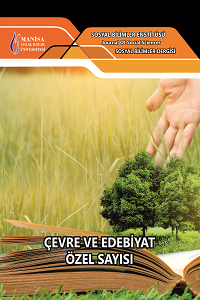Öz
Published in 1894, The Jungle Book by Rudyard Kipling has become a great
success in England. Telling the story of Mowgli who is raised by the animals in
the Jungle, the book portrays Mowgli and animals as symbolizing the
reunification of human beings and nature. The story is generally perceived as a
Bildungsroman with undertones of imperialist discourse or Mowgli is perceived
as a romantic hero who represents the noble savage that embraces and reunites
with nature. However a closer look reveals the fact that the depictions of
nature sanctified, function as discursive reproduction of its materialization
and reinforcement of the modern hierarchy between man and nature and culture
and nature. Thus, the aim of this article is to propose a fresh look at
Kipling’s text through the frame of human-animal studies.
Anahtar Kelimeler
Rudyard Kipling The Mowgli Stories imperialism binary of man and nature
Kaynakça
- ADAMS, Carol J (2003), The Pornography of Meat, Continuum, New York. ARMSTRONG, Philip (2011), “The Gaze of Animals,” Theorizing Animals: Re-thinking Humanimal Relations, (eds.) Nik Taylor and Tania Signal, Brill, Leiden and Boston, ss. 175-202. BEATSON, Peter (2011), “Mapping Human Animal Relations.” Theorizing Animals: Re-thinking Humanimal Relations, (eds.) Nik Taylor and Tania Signal, Brill, Leiden and Boston, ss. 21-58. BERGER, John (1991), “Why look at Animals? About Looking, Vintage, New York. DELUZE, Gilles and Felix GUATTARİ (1983), Anti-Oedipus, (trans.) Robert Hurley, Mark Seem and Helen R. Lane, U of Minneapolis P, Minneapolis. DERRIDA, Jacques (2002), “The Animal That Therefore I Am,” Critical Inquiry 28.2, ss. 369-418. GÖKÇEN, Nilsen (2015), Encountering the Animal: Explorations in American Literature, Boyut, Ankara. FOUCAULT, M (2008), The History of Sexuality Volume 1 (1976). Penguin, Camberwell, Victoria. HARAWAY, Donna (2006), “Encounters with Companion Species: Entangling Dogs, Baboons, Philosophers, and Biologists,” Configurations 14.1.2, ss. 94-114. KEMMERER, Lisa (2011), “Theorizing Others.” Theorizing Animals: Re-thinking Humanimal Relations. (eds.) Nik Taylor and Tania Signal, Brill, Leiden and Boston, ll, ss. 59-84. KIPLING, Rudyard (2016), The Jungle Book, Macmillan, London. NATH, Dipika (2009), “ ‘To Abandon the Colonial Animal’: ‘Race,’ Animals and the Feral Child in Kipling’s Mowgli Stories,” Animals and Agency: An Interdisciplinaty Exploration, (eds.) Sarah H McFarland and Ryan Hediger, Brill, Leiden and Boston, ss. 251-278. PUGLIESE, Joseph (2017), “Terminal Truths: Foucault’s Animals and the Mask of the Beast,” Foucault and Animals, (eds.) Matthew Chrulew and Dinesh Joseph Wadiwel, Brill, Leiden and Boston, ss. 19-36. SAVAGE-RUMBAUGH, Sue (2004), Kanzi: The Ape at the Brink of the Human Mind, John Wiley and Sons, New Jersey. SZARYCS, Gregory S. (2011), “The Representations of Animal Actors: Theorizing Performance and Performativity in the Animal Kingdom,” Theorizing Animals: Re-Thinking Humanimal Relations, (eds.) Nik Taylor and Tania Signal, Brill, Leiden and Boston, ss. 149-174. WEIL, Kari (2012), Thinking Animals, Columbia UP, New York.
Ayrıntılar
| Birincil Dil | İngilizce |
|---|---|
| Bölüm | Makaleler |
| Yazarlar | |
| Yayımlanma Tarihi | 16 Mayıs 2018 |
| Yayımlandığı Sayı | Yıl 2018 Cilt: 16 Sayı: 1/2 |


